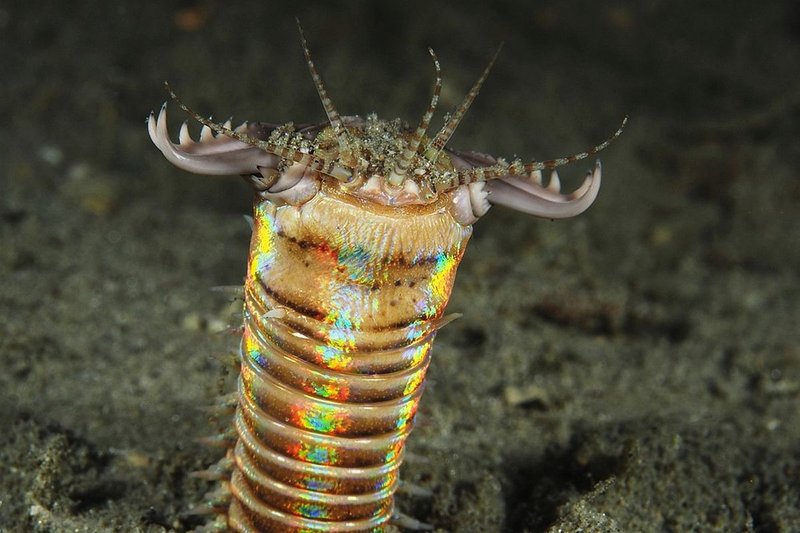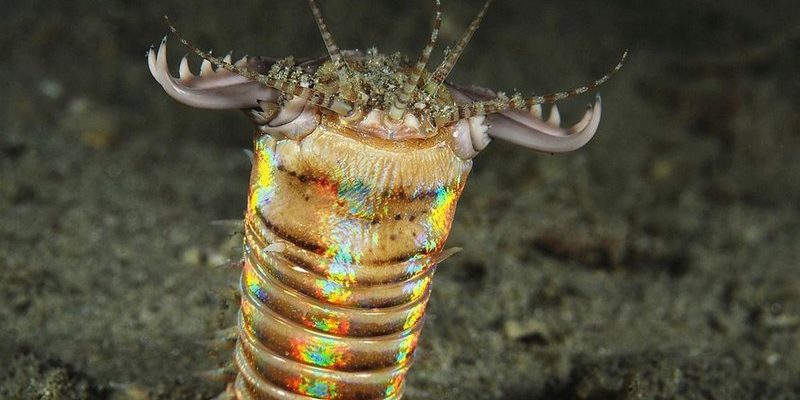
To get started, you’ll want to arm yourself with the right tools. A good underwater camera—like the GoPro Hero series or a robust DSLR with waterproof housing—is essential. Also, don’t forget your trusty dive light; it’s your best friend when navigating the dark waters and revealing the beauty of the Bobbit worm’s habitat. Let’s dive into some essential tips for photographing these remarkable creatures at night.
Understanding Bobbit Worm Behavior
Before you even think about snapping pictures, it helps to understand how Bobbit worms behave. These mesmerizing creatures can grow up to 10 feet long and often blend in with their surroundings—so spotting one can be a challenge. They typically reside in sandy or muddy substrates and prefer areas that provide them with cover, which makes them stealthy hunters.
You might wonder how these worms capture their prey. They have long, sharp jaws that they use to snatch fish and crustaceans as they swim by. When the sun sets, Bobbit worms become more active, making night a prime time for photography. The best way to find them is to look for their colorful bristles peeking out of the sand. It’s like searching for hidden treasures in a treasure chest!
It’s also good to remember that Bobbit worms can be sensitive to light. So, while you do want to illuminate your subject, be mindful of how bright your lights are.
Choosing the Right Equipment
Having the right gear makes a world of difference. To photograph Bobbit worms effectively, you’ll need a camera that can handle low light. Here are some recommendations:
- Underwater DSLR or Mirrorless Cameras — Cameras like the Canon EOS R series are excellent choices due to their high sensitivity in low light.
- GoPro Hero — This compact option is perfect for capturing wide shots and is waterproof right out of the box.
- Lightweight Tripods — These can help stabilize your camera in the water, minimizing shake during your shots.
Also, don’t overlook accessories like macro lenses or close-up filters. Bobbit worms have incredible textures and colors that can be beautifully captured with a good lens.
Lastly, have a reliable dive light on hand. A bright, focused beam will not only help illuminate the worms but also enhance color saturation in your photos.
Mastering Underwater Lighting Techniques
When it comes to underwater photography, lighting can make or break your shots. Honestly, you don’t want to end up with blurry, dark images that don’t do justice to these stunning creatures. Here are a few techniques to ensure your photos pop:
1. Positioning Your Light: Aim your dive light at a 45-degree angle towards the worm. This will create shadows and depth, highlighting the stunning colors and textures.
2. Experimenting with Filters: If your camera allows, try using filters to reduce the blue tint that often shows up in underwater photos. This can restore the vibrant colors of the Bobbit worm.
3. Using a Strobe Light: If you have access to a strobe light, don’t hesitate to use it! It can greatly enhance the color and clarity of your underwater shots.
You might be wondering about the best time to dive. Late evening to just after sunset is often ideal. This is when Bobbit worms are most active, and the ambient light begins to fade, allowing your dive light to shine through.
Positioning Yourself for the Perfect Shot
Finding the right angle can transform a good photo into an incredible one. Here are some tips to help you get perfectly positioned for those stunning shots:
– Get Low: Being at the same level as the Bobbit worm will create a greater sense of intimacy in your photos. It’s like getting down to a friend’s level when taking a portrait; it feels more personal.
– Choose Your Depth Wisely: Make sure you’re in a comfortable depth while still being close enough to capture clear images. If the current is too strong, you might want to adjust your position to avoid disturbing the sand.
– Be Patient: Bobbit worms can be skittish, so if they retreat into their burrows, give them some time. Stay still, and they might come back out, ready for their close-up.
By getting the right angles and being patient, you’ll be able to capture the Bobbit worm’s unique form and colors beautifully.
Editing Your Nighttime Photos
Once you’ve captured those stunning images, the fun doesn’t stop there! Editing can elevate your photos to a whole new level. Here are some simple tips to help you polish your shots:
1. Adjust Brightness and Contrast: Sometimes, underwater shots can look flat. A quick boost in brightness and contrast can bring out the colors and details of your Bobbit worm.
2. Enhance Colors: Use editing software to punch up the colors. This is where you can really make those vibrant hues stand out against the ocean backdrop.
3. Crop for Impact: Don’t be afraid to crop your images. A tighter shot can draw attention to the Bobbit worm and eliminate distracting elements in the background.
Honestly, even a small amount of editing can turn a nice photo into a fantastic one. So take the time to play around with your images and see what you can create!
Respecting the Environment While Photographing
As captivating as these creatures are, it’s essential to remember that they call the ocean their home. Here are some important points to practice sustainable photography:
– Minimize Disturbance: Avoid kicking up sand or disturbing the surrounding habitat. The Bobbit worm thrives in delicate ecosystems, and your presence should not disrupt this balance.
– Don’t Touch: It might be tempting to get a little closer for that perfect shot, but touching marine life can harm both you and them. Enjoy observing, but keep your distance.
– Follow Local Guidelines: When diving in specific areas, adhere to local regulations regarding wildlife and photography. This ensures that future generations can enjoy these remarkable creatures, too.
By approaching Bobbit worms respectfully, you help preserve their environment and ensure that this underwater treasure continues to thrive for years to come.
In conclusion, photographing Bobbit worms at night is an exhilarating experience that combines adventure, creativity, and respect for nature. Armed with the right tools, knowledge of their behaviors, and a commitment to sustainability, you’re set for an unforgettable underwater journey. So grab your camera, dive in, and capture the mysteries that lie beneath the waves!

